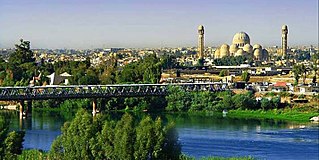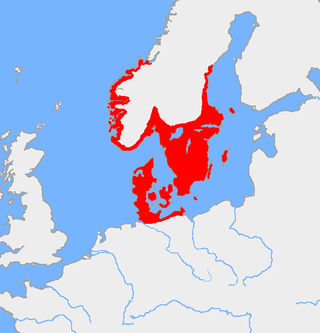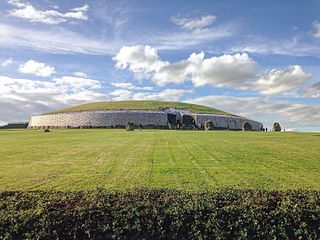The Chalcolithic was an archaeological period characterized by the increasing use of smelted copper. It followed the Neolithic and preceded the Bronze Age. It occurred at different periods in different areas, but was absent in some parts of the world, such as Russia, where there was no well-defined Copper Age between the Stone and Bronze Ages. Stone tools were still predominantly used during this period.

Pottery is the process and the products of forming vessels and other objects with clay and other raw materials, which are fired at high temperatures to give them a hard and durable form. The place where such wares are made by a potter is also called a pottery. The definition of pottery, used by the ASTM International, is "all fired ceramic wares that contain clay when formed, except technical, structural, and refractory products". End applications include tableware, decorative ware, sanitary ware, and in technology and industry such as electrical insulators and laboratory ware. In art history and archaeology, especially of ancient and prehistoric periods, pottery often means only vessels, and sculpted figurines of the same material are called terracottas.

Mosul is a major city in northern Iraq, serving as the capital of Nineveh Governorate. The city is considered the second-largest city in Iraq in terms of population and area after the capital Baghdad. Mosul is approximately 400 km (250 mi) north of Baghdad on the Tigris river. The Mosul metropolitan area has grown from the old city on the western side to encompass substantial areas on both the "Left Bank" and the "Right Bank", as locals call the two riverbanks. Mosul encloses the ruins of the ancient Assyrian city of Nineveh – once the largest city in the world – on its east side.
During the 40th century BC, the Eastern Mediterranean region was in the Chalcolithic period, transitional between the Stone and the Bronze Ages. Northwestern Europe was in the Neolithic. China was dominated by the Neolithic Yangshao culture. The Americas were in a phase of transition between the Paleo-Indian (Lithic) to the Meso-Indian (Archaic) stage. This century started in 4000 BC and ended in 3901 BC.

The Bell Beaker culture, also known as the Bell Beaker complex or Bell Beaker phenomenon, is an archaeological culture named after the inverted-bell beaker drinking vessel used at the very beginning of the European Bronze Age, arising from around 2800 BC.

Wilburton is a small village of just over 1,000 inhabitants, situated in Cambridgeshire, England. It is 6 miles south west of Ely. While nominally an agricultural village, many residents work in Cambridge, Ely or London.

The Dartmoor line is a 15+1⁄2-mile (24.9 km) railway line in Devon, England. From Crediton, the line runs alongside the Tarka Line to the site of the former Coleford Junction where it diverges west to Okehampton. Previously a heritage line, it is owned by Network Rail.

The Nordic Bronze Age is a period of Scandinavian prehistory from c. 2000/1750–500 BC.

Pottery, due to its relative durability, comprises a large part of the archaeological record of ancient Greece, and since there is so much of it, it has exerted a disproportionately large influence on our understanding of Greek society. The shards of pots discarded or buried in the 1st millennium BC are still the best guide available to understand the customary life and mind of the ancient Greeks. There were several vessels produced locally for everyday and kitchen use, yet finer pottery from regions such as Attica was imported by other civilizations throughout the Mediterranean, such as the Etruscans in Italy. There were a multitude of specific regional varieties, such as the South Italian ancient Greek pottery.
The Wilburton-Wallington Phase is the name given by archaeologists to a metalworking stage of the Bronze Age in Britain spanning the period between c. 1140 BC and c. 1020 BC.
The Mount Pleasant Period is a phase of the later Neolithic in Britain dating to between c. 2750 BC and 2000 BC. It was so named by Colin Burgess in the 1970s using Mount Pleasant henge as its typesite. The period is divided into three phases, the Frankford industries, the Migdale-Marnoch industries and then the Ballyvalley-Aylesford industries. During this period, Beaker pottery appears in the archaeological record and metalworking, initially using copper and gold but with bronze working appearing at the end. It followed the Meldon Bridge Period and was superseded by the Overton Period. There are parallels with the Unetice culture of continental Europe.
The Overton Period is the name given by archaeologist Colin Burgess to a division of prehistory in Britain covering the period between 2000 BC and 1650 BC.
The Knighton Heath Period is the name given by Colin Burgess to a phase of the Bronze Age in Britain following the Bedd Branwen Period and spanning the period 1400 BC to 1200 BC. It was succeeded by the Penard Period.
The Penard Period is a metalworking phase of the Bronze Age in Britain spanning the period c. 1275 BC to c. 1140 BC.

Pushkalavati, was the capital of the ancient region of Gāndhāra, situated in present day's Pakistan. Its ruins are located on the outskirts of the modern city of Charsadda, in Charsadda District, in the Khyber Pakhtunkhwa, 35-42 kilometres northeast of Peshawar, at the banks of Jindi River, near the junction of Swat River with Kabul River. The earliest archaeological remains in Bala Hisar mound are from 1400 to 800 BCE. Pushkalavati may have been incorporated as an Achaemenid regional settlement around 520 BCE, and it remained an important city through to the beginning of 3rd century CE.

Chinese ceramics are one of the most significant forms of Chinese art and ceramics globally. They range from construction materials such as bricks and tiles, to hand-built pottery vessels fired in bonfires or kilns, to the sophisticated Chinese porcelain wares made for the imperial court and for export.

The prehistory of Ireland has been pieced together from archaeological evidence, which has grown at an increasing rate over the last decades. It begins with the first evidence of permanent human residence in Ireland around 10,500 BC and finishes with the start of the historical record around 400 AD. Both the beginning and end dates of the period are later than for much of Europe and all of the Near East. The prehistoric period covers the Palaeolithic, Mesolithic, Neolithic, Bronze Age and Iron Age societies of Ireland. For much of Europe, the historical record begins when the Romans invaded; as Ireland was not invaded by the Romans its historical record starts later, with the coming of Christianity.

Prehistoric art in Scotland is visual art created or found within the modern borders of Scotland, before the departure of the Romans from southern and central Britain in the early fifth century CE, which is usually seen as the beginning of the early historic or Medieval era. There is no clear definition of prehistoric art among scholars and objects that may involve creativity often lack a context that would allow them to be understood.

Persian pottery or Iranian pottery is the pottery made by the artists of Persia (Iran) and its history goes back to early Neolithic Age. Agriculture gave rise to the baking of clay, and the making of utensils by the people of Iran. Through the centuries, Persian potters have responded to the demands and changes brought by political turmoil by adopting and refining newly introduced forms and blending them into their own culture. This innovative attitude has survived through time and influenced many other cultures around the world.
Yarim Tepe is a Neolithic settlement in the eastern Gorgan plain, Golestan Province. It is located near Gonbad-e Kavus. This ancient settlement played a big role in establishing the cultural chronology of the neolithic period in Central Asia.











